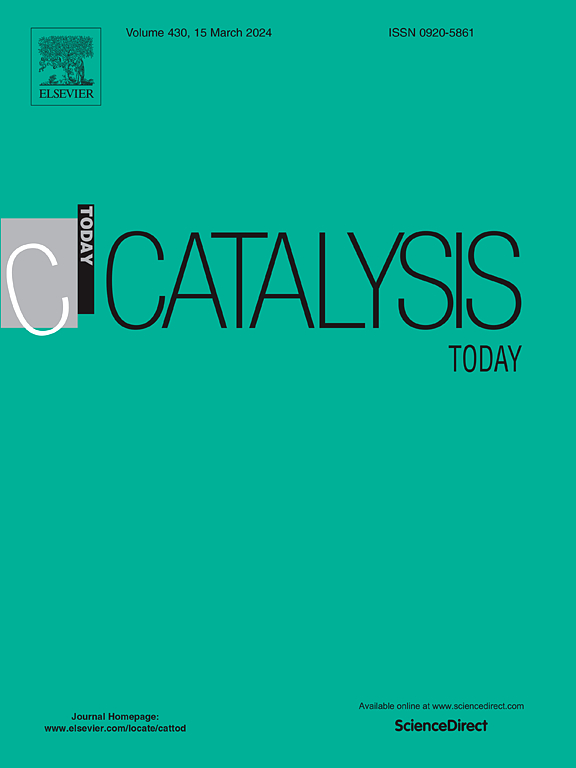IF 5.2
2区 化学
Q1 CHEMISTRY, APPLIED
引用次数: 0
摘要
通过水热法在钛酸锶光催化剂中掺入铑(0、1、5、10 和 15%),以提高其可见光吸收率。通过 X 射线衍射仪、X 射线光电子能谱、红外光谱、氮吸附、扫描和透射电子显微镜、漫反射光谱和光致发光测量对样品进行了表征。以不含铑的样品为参照物,通过可见光照射下苯酚的光催化氧化作用评估了它们的光催化活性。所有掺入的铑都成功地融入了立方晶格。掺杂铑后,可见光吸收明显增强,电荷重组受到抑制。光催化活性在很大程度上得到了增强:最好的样品在可见光下 1 小时就能完全降解苯酚。最佳铑含量为 5%。光催化活性高的原因是可见光吸收率增强、电荷重组受抑制以及 Rh3+/Rh4+ 比率高。本文章由计算机程序翻译,如有差异,请以英文原文为准。
Visible-light-active Rh-doped SrTiO3: Effect of Rh doping on the structural characteristics contributing to outstanding photocatalytic activity
Strontium titanate photocatalysts were doped with rhodium (0, 1, 5, 10, and 15 at%) via a hydrothermal method to enhance their visible light absorbance. The samples were characterized by X-ray diffractometry, X-ray photoelectron spectroscopy, infrared spectroscopy, nitrogen adsorption, scanning and transmission electron microscopy, diffuse reflectance spectroscopy, and photoluminescence measurements. Their photocatalytic activity was evaluated by the photocatalytic oxidation of phenol under visible light irradiation, using the non-Rh-containing sample as a reference. All the applied rhodium was successfully incorporated into the cubic crystal lattice. Rhodium doping resulted in significantly enhanced visible light absorption and suppressed charge recombination. The photocatalytic activity was enhanced to an exceptionally large degree: the best sample completely degraded phenol in 1 h under visible light. The optimal rhodium amount was found to be 5 at%. The high photocatalytic activity was attributed to the resultant effect of enhanced visible light absorbance, suppressed charge recombination, and high Rh3+/Rh4+ ratio.
求助全文
通过发布文献求助,成功后即可免费获取论文全文。
去求助
来源期刊

Catalysis Today
化学-工程:化工
CiteScore
11.50
自引率
3.80%
发文量
573
审稿时长
2.9 months
期刊介绍:
Catalysis Today focuses on the rapid publication of original invited papers devoted to currently important topics in catalysis and related subjects. The journal only publishes special issues (Proposing a Catalysis Today Special Issue), each of which is supervised by Guest Editors who recruit individual papers and oversee the peer review process. Catalysis Today offers researchers in the field of catalysis in-depth overviews of topical issues.
Both fundamental and applied aspects of catalysis are covered. Subjects such as catalysis of immobilized organometallic and biocatalytic systems are welcome. Subjects related to catalysis such as experimental techniques, adsorption, process technology, synthesis, in situ characterization, computational, theoretical modeling, imaging and others are included if there is a clear relationship to catalysis.
 求助内容:
求助内容: 应助结果提醒方式:
应助结果提醒方式:


